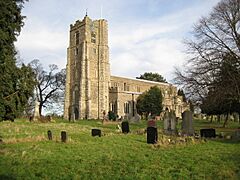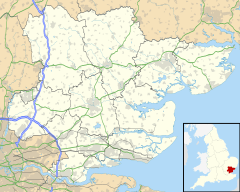Hatfield Broad Oak facts for kids
Quick facts for kids Hatfield Broad Oak |
|
|---|---|
 The Church of St Mary the Virgin |
|
| Population | 904 |
| OS grid reference | TL546166 |
| • London | 25 mi (40 km) SW |
| District |
|
| Shire county | |
| Region | |
| Country | England |
| Sovereign state | United Kingdom |
| Post town | Bishop's Stortford |
| Postcode district | CM22 |
| Dialling code | 01279 |
| Police | Essex |
| Fire | Essex |
| Ambulance | East of England |
| EU Parliament | East of England |
| UK Parliament |
|
Hatfield Broad Oak is a village in the Uttlesford area of Essex, England. It's also known as Hatfield Regis. The village is about 5 miles (8 km) south-east of Bishop's Stortford. Near the village church, called St Mary the Virgin, you can find the remains of an old Benedictine priory (a type of monastery).
Contents
History of Hatfield Broad Oak
People have lived in the Hatfield Broad Oak area for a very long time. Signs of human life from the Bronze Age (thousands of years ago) have been found here. This includes a mound called the Portingbury Hills in Hatfield Forest.
Early Beginnings and Royal Connections
The village of Hatfield was already well-known by the time of the Norman Conquest in 1066. It was even listed in the famous Domesday Book, a big survey of England from 1086. Back then, it was the ninth largest settlement in Essex, with 115 people.
At one point, Hatfield was a special "royal manor" (land owned by the king) of King Harold I. After the Norman Conquest, it became the property of William the Conqueror. Kings enjoyed hunting in the nearby forest, so the village became known as Hatfield Regis, which means "King's Hatfield." This helped tell it apart from another village in Essex called Hatfield Peverel.
By the time the priory in Hatfield Broad Oak was closed down, the village had grown to over 1,000 residents.
The Famous Oak Tree and Hatfield Forest
The name Hatfield Broad Oak has been used since at least 1136. The "eponymous oak" (the oak tree that gave the village its name) was first mentioned in records in 1295.
Today, Hatfield Forest still has the fenced-off remains of a very large oak tree called the "Doodle Oak." Experts believe it's about 850 years old! However, it's thought to be a different tree from the one that originally named the village.
Hatfield Forest is a very old woodland. It's protected as a Site of Special Scientific Interest (SSSI) and a National Nature Reserve (NNR). It is now looked after by the National Trust, a charity that protects important places. Even today, the hedges around Hatfield Broad Oak follow the old boundaries of the ancient forest.
Hatfield was once a busy market town. In 2001, about 1,600 people lived there. By 2021, the population had changed to 904.
Community Life in Hatfield Broad Oak
The parish (local area) of Hatfield Broad Oak is quite large, covering about 8,800 acres (35.6 km²). It stretches about 4 miles (6.4 km) north of the village. In the past, it was divided into four "quarters": Town Quarter, Woodrow Quarter, Heath Quarter, and Broomsend Quarter.
At the northern end of the parish is Hatfield Forest, famous for its large oak trees. About 1 mile (1.6 km) north of the main village is a smaller village called Bush End. It has its own church, St John the Evangelist, which was built in 1856.
The Cock Inn, a local pub, has been around since the 1400s! St Mary's Church of England primary school opened in 1816 as a National school.
Every May Bank holiday, since 1985, the village hosts a 10-kilometre road race. Runners follow a course around the village.
The Village Church
A Saxon church was present in Hatfield when the Domesday Book was written. The current parish church, St Mary the Virgin, is from the early medieval period. It has a stone tower with eight bells. The largest bell weighs about 860 kg and was made in 1782.
The parish church was once part of the priory church. It was rebuilt for the local community towards the end of the 1300s and expanded over the next century.
Inside the church, you can find a stone statue of Robert de Vere, 3rd Earl of Oxford, who was buried there in 1221. One of the church rooms holds old writings from the Barrington family of Barrington Hall. Another room has a library, which was set up in 1708 by Sir Charles Barrington.
Local Governance
Hatfield Broad Oak is part of an "electoral ward" called Broad Oak and the Hallingburys. An electoral ward is an area that elects representatives to the local council. In 2011, this ward had a population of 3,571 people.
See also
 In Spanish: Hatfield Broad Oak para niños
In Spanish: Hatfield Broad Oak para niños


